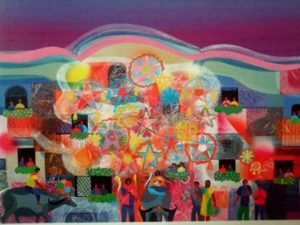It’s December, which means the holidays are upon us—but how do educators best address them in the classroom?
December is a joyful time for many Americans—and not just those who celebrate Christmas as a sacred holiday or cultural event. Jews celebrate Hanukkah, Buddhists celebrate Bodhi Day, many African Americans celebrate Kwanzaa, and cultures across the world celebrate the Winter Solstice.
For educators, however, the convergence of so many holidays can create the December dilemma: how to acknowledge and respect the wide variety of holidays and traditions their students hold dear without implying that some are more important than others.
For most of the 20th century, there was no recognition of a December dilemma.

Painting by Manuel D. Baldemor
Schools routinely marked the coming of Christmas with religious pageants, nativity scenes, and organized prayer. Students of different faiths or no faith were marginalized and excluded. Since the U.S. Supreme Court struck down school prayer in the 1960s, schools have abandoned such religious rituals, and many have struggled to develop more inclusive holiday programs.
Most teachers are well aware of the history surrounding holiday celebrations, including recent charges by some commentators that Christmas has been secularized and marginalized in pursuit of multiculturalism. During Tanenbaum’s webinar, Addressing the December Dilemma in Schools, participants were asked what words and phrases came to mind when they heard “December dilemma.” Responses included “crazy,” “stress,” “offend,” “only acknowledging Christmas,” and “children feeling left out”—conveying the apprehension teachers feel about celebrating the season without excluding any students or favoring any traditions.
Not all participant responses were negative, however.
One said, “How to honor and recognize people’s cultures and values without excluding anyone,” and another said, “Uncomfortable, but an opportunity.” These responses get to the heart of the matter. While the December dilemma presents real challenges for educators, it also offers tremendous opportunities: to include a wider range of religious and cultural traditions in their teaching; to promote religious literacy and respect for differences; and to foster a culture of inclusion.
Here are six ways educators can embrace these opportunities:
1. Move beyond Christmas, Hanukkah, and Kwanzaa. One way to solve the December dilemma is to focus less on December and more on the many holidays that take place throughout the year. For instance, Rosh Hashanah and Passover—two of the highest holidays in Judaism—are seldom discussed while greater attention is given to Hanukkah because it usually falls in December. The Islamic holy month of Ramadan, which occurs at varying times of the year, also tends to be overlooked when it doesn’t fall in December. Learning more about these and other holidays deepens students’ understanding of their classmates, their community, and the world.
Harvard’s Pluralism Project offers a comprehensive multi-faith calendar, which can be used with Tanenbaum’s holiday planning template, to create a yearlong schedule of holidays to explore in the classroom. Teachers can connect these diverse celebrations through a thematic framework of values common to different religious and secular traditions—such as peace, caring, thankfulness, forgiveness, and renewal. For more ideas, see Tanenbaum’s Shared Visions.
For an elementary lesson that introduces a variety of winter holidays related to light, download Tanenbaum’s Rituals and Traditions about Light: Hopefulness and Waiting.
2. Use holidays as an opportunity to dig deeper. Go beyond how, when, and where people celebrate to why they celebrate and the many different ways they celebrate, even within the same tradition. Avoid monolithic representations of groups by exposing students to the lived experiences of real people, allowing them to read personal narratives, interact with guest speakers, and interview community members. By exploring the diversity within diversity, students gain a deeper knowledge of culture, history, geography, literature, art, music, and more. Just as important, they begin to see religious and cultural differences as normal and interesting.
For information about a variety of holidays, go to the BBC’s Directory of Religions. To learn more about the major world religions, read the World Religions Fact Sheet.
3. Encourage students to explore their own identities and traditions. Lessons that allow students to explore and share aspects of their identities—including their religious and cultural traditions—help them become cognizant of, and interested in, the similarities and differences that exist all around them. As they learn more about themselves, they become better prepared to learn about others.
For an elementary lesson that encourages students to explore their family traditions, download My Traditions.
4. Ensure a safe, respectful classroom environment. When discussing religious and cultural traditions in the classroom, it’s crucial to establish and reinforce ground rules for respectful communication so that all students feel comfortable participating. Part of this is teaching students how to ask questions respectfully—for instance, “What holidays are important to you?” instead of, “Why don’t you celebrate Christmas?”
Go to Respecting Each Other for a K-12 lesson in which students reflect on the meaning of respect and create a set of ground rules for how to treat one another.
5. Understand your responsibilities under the First Amendment. The Supreme Court has made it clear that educators can teach about religious holidays, practices, and beliefs, but they may not celebrate, endorse, or denigrate any religious holidays, practices, or beliefs. All lessons about religion must be neutral, objective, and non-devotional.
The First Amendment Center’s Finding Common Ground provides legal guidelines for addressing religious holidays in public school, including guidelines for holiday decorating, assemblies, and musical performances.
6. Communicate with parents about any plans to teach about religious holidays, practices, and beliefs. Explain the academic goals of these lessons, emphasizing that students will be learning about religious differences, not being indoctrinated in a different religion. Be prepared to answer questions and allay concerns. Some family members may be willing to speak to the class about their traditions and share primary sources such as photos or videos. Such presentations can bring the lesson to life and are entirely appropriate as long they are non-devotional and family members are asked to speak from their own experiences, not as spokespersons for a religious or cultural group.
With these strategies, educators can turn the December dilemma into an opportunity to promote religious literacy and respectful curiosity—important global competencies for the 21st century.
Connect with Tanenbaum and Asia Society on Twitter.
In 2015, Asia Society and BOOST Collaborative are partnering to create a series of blogs on global learning in out-of-school time. This blog entry was originally published on EdWeek’s Global Learning Blog.
Author: Kimberly Keiserman
Photo credit: Joey Ramone
